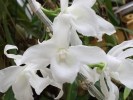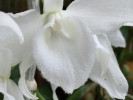|
|
|
|
|
| |
Established Seedlings of
Dendrobium anosmum var. alba 'MC1072' × self |
|
| |
|
|
| |
| Number: |
TN2374 |
| Name: |
Dendrobium anosmum var. alba 'MC1072' × self
|
| Type: |
self (What's that?) |
|
Seed Donor: |
Glen Ladnier
|
|
Click to Enlarge

Offspring 'MC7326' Flower |
Click to Enlarge

Offspring 'MC7326' Closeup of Flower |
| Offspring photos are siblings of the plants you would receive. |
|
|
|
| |
Culture Notes from Donor: Parent plant: Temperature range I (60-83°F)
Comments: Parent plant: The blossoms are the typical anosmum shape, but with no lavender color on them at all.
For additional origin/habitat information supplied courtesy of
Charles and Margaret Baker, see further below, near the bottom of this page.
|
Temperatures we attempt to use in the lab & greenhouse:
| For Species: |
|
Spring, Summer, Autumn, Winter: days average 82°F, nights 64°F; best fit is Intermediate 83-60°F
(Source:
Baker's Web OSC) |
|
About the name...
| Etymology of |
alba |
|
From Latin "albus" white.
(Source:
Brown 1956) |
| Etymology of |
anosmum |
|
From latinized Greek "anosmus" odorless.
(Source:
Mayr & Schmucker 1998) |
| Etymology of |
Dendrobium |
|
From Greek "dendron" tree and "bios" life.
(Source:
Pridgeon 1992) |
| Pronunciation of |
alba |
|
AL-ba
(Source:
Hawkes 1978) |
| Pronunciation of |
Dendrobium |
|
den-DRO-bee-um
(Source:
Pridgeon 1992) |
|
If you would like to direct someone to this web page, please copy and paste this URL into your email:
http://troymeyers.com/d?122374
|
ESTABLISHED SEEDLINGS
of these are not currently available, but we have some maturing in the greenhouse and expect to offer them in the future.
There are 13 items with
1 plant per
item that will be considered for sale later.
Click here to see if we have flasks available.
|
|
|
| |
The origin/habitat information below is supplied courtesy of Charles and Margaret Baker
The following information is based on the name of the plant provided by the donor, and assumes that the name is correct. If the plant has been misidentified, then the following information may not be correct.
This text is copyrighted by the Bakers and may not be reproduced without permission.
ORIGIN/HABITAT: Widespread. Plants are found from the Philippines to New
Guinea, including Borneo and many islands in Indonesia. They are also
found in Malaya, peninsular Thailand, Laos, Vietnam, and Sri Lanka. On
Luzon Island and in Davao Province on Mindanao Island in the Philippines,
plants grow in mountain forests usually below 2450 ft. (750 m). D. anosmum
often grows in association with Aerides quinquevulnerum and Anota
violacea. In Papua New Guinea, plants are common in the Bulolo and Wau
areas where they grow on rough-barked trees from sea level to 4250 ft.
(0-1300 m).
More about this information and the Bakers...
|
|
|
| |
|
|
|